 |
|

|
 |
TABLE of CONTENTS
 |
Twin Ports Interchange project rolls along in its third year |
By Pippi Mayfield, District 1 public engagement and communications director

I-35 interchange: Looking northbound toward Duluth, the I-35 mainline will be open with four lanes this fall. Crews continue to construct the connecting on and off ramps. Drone photo by Cheri Gagne, Office of Aeronautics |
In its third year, the Twin Ports Interchange project in Duluth is continuing to make major progress. When completed, the $435 million project will replace aging infrastructure at the I-35, I-535 and Hwy 53 interchanges and bridges, improve safety by eliminating blind merges and left exits, and better accommodate freight movements. MnDOT is aiming to complete the project in 2025.
Due to Duluth’s rich history, some items of cultural significance were discovered earlier this year during soil excavation, which has led MnDOT to adjust timelines on portions of the project. Since the discovery, MnDOT has been working closing with the Minnesota Indian Affairs Council, tribal partners and other stakeholders to find ways to move forward that while respecting cultural resources – including closely monitoring for additional cultural resources – without unduly impacting the public by leaving critical transportation connections disconnected in Duluth.
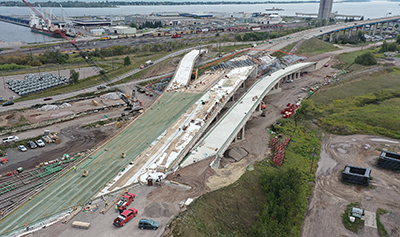
The Garfield Avenue/I-535 interchange, located at the approach to Blatnik Bridge, is under construction. Drone photo by Cheri Gagne, Office of Aeronautics |
This fall, MnDOT contractors were able to accelerate a portion of the work that had been scheduled for next spring. For the remainder of October, I-35 traffic will be two lanes northbound and one lane southbound for shoulder grading, paving, wall painting and pouring of barrier wall. I-35 will then be open to four lanes for the winter season with just a few short lane closures next spring and summer for clean-up work.
“We can finish paving and get the permanent barrier wall done along the south side. It was work scheduled to be in the spring and summer of 2024, but we made the decision to just try and get it done this year. The benefit is to minimize our need to impact traffic on I-35 next year,” Construction Manager Pete Marthaler said.
The fall checklist also includes painting, installing guardrails, road striping and hanging lights.
“Fingers crossed, but we think we can do it,” he added.
Throughout the project, MnDOT and its contractors have continued to stress the importance of safety. There are about 130 workers onsite daily, with about 720,000 hours worked since the start of the project. There have only been eight recordable injuries in that time.
The district continues to host virtual public update meetings every two months, and the Office of Aeronautics flies the project each month, taking drone shots to use for outreach and many other purposes. |
| |
|

|
 |
TABLE of CONTENTS
 |
DVS and MnDOT work together to offer pavement striping training to certified small businesses |
By Adam Marks and Su Love, Office of Civil Rights
coordinator
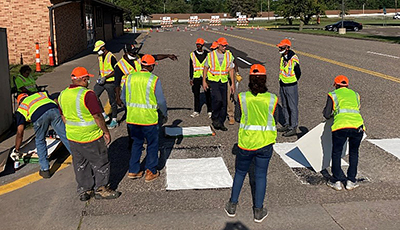
MnDOT pavement striping trainees learn how to make a crosswalk.
Photo by Adam Marks
|
Visitors to the Arden Hills North Metro Drivers Exam Station will notice some upgrades the next time they enter, thanks to a training collaboration between MnDOT and the Department of Public Safety Driver and Vehicle Services Division.
In August, MnDOT’s Office of Civil Rights held a pair of two-day trainings to help BIPOC- and women-owned small businesses learn about pavement striping and compete for work on MnDOT projects. Metro District staff partnered with small businesses Professional Engineering Services, Inc. and AMKA Safety to teach other small-business owners and give them the opportunity to apply new pavement-striping skills while replacing crosswalks at the North Metro Exam Station. Metro District staff demonstrated equipment, answered questions and assisted in removing existing pavement markings.
Pavement striping offers expansive opportunities for BIPOC- and women-owned small businesses.
“Pavement marking is one of the few scalable needs faced by MNDOT and other agencies,” explained Eric Johnson, the senior inspector for PE Services, one of the two small business collaborators that provided training. “The jobs can range in scope from individual intersections with relatively few lines and markings to full civil project striping projects requiring miles of lines and many varying symbols and markings to be applied. This quality allows contractors to build their experience and business at a pace not difficult to accommodate.”
“This class allowed us to move well beyond the scope of traditional MnDOT training,” Johnson said. “The hands-on approach was invaluable in helping students truly understand the requirements associated with successfully delivering a striping project.”
Gabe Briseno of Metro District said that participants were “more than willing to learn and absorbed the knowledge well. They were eager to learn the use of equipment and excited for the next day. I really enjoyed being able to be a part of this training for small businesses and put MnDOT’s best foot forward.”
Office of Civil Rights training programs assist BIPOC-owned, woman-owned and veteran-owned businesses, as well as socially and economically disadvantaged business owners, to be competitive on MnDOT contracts and projects. Evidence shows that businesses within these categories of ownership experience disparities in contracting. These training programs exist to change this experience. Small business owners interested in participating in MnDOT’s equity-based programs must get formal certification. (Learn more about this on OCR’s “become a certified small business” webpage.)
The North Metro Exam Station typically operates seven days per week, which makes it challenging to coordinate infrastructure improvements. To accommodate the trainings, the DVS Division rerouted their drivers’ exam course for the duration of the trainings so that MnDOT staff, training providers and participants had a safe space to work. By partnering with the DVS Division, OCR was able to offer these hands-on trainings in a controlled, realistic setting while helping improve Department of Public Safety infrastructure.
“We really appreciated the opportunity to make the Arden DVS exam station look good “ said DVS supervisor Jessica Cook. “The work they did was great! I hope we can work with MnDOT again in the future.”
The Office of Advancing Equity, another key collaborator, helped create the plans for the intersection improvements. The Office of Civil Rights extends a big thanks to Advancing Equity staff Rich Haavisto and Mindy Heinkel, Metro District staff Rick Burger, Gabe Briseno, and Jeff Streeter, and DVS staff Jennifer Nelson, Jessica Cook, and Mark Larson for their help in making this program a success. |
| |
|

|
 |
TABLE of CONTENTS
 |
Kirby Becker joins Aeronautics on permanent basis |
|
After an 11-month work out of class opportunity as one of two Aeronautics Assistant Directors, Kirby Becker has joined the Office of Aeronautics on a permanent basis and will continue in his role overseeing our Business Services, Airport Development and Planning Sections.
Becker has 23 years of public and private experience in transportation planning and engineering, and has been with MnDOT since 2011. Prior to coming to joining Aeronautics, he was supervisor for the Innovation, Data, Evaluation, and Asset Management Unit for MnDOT’s Office of Transit and Active Transportation, a position he held for the previous four years. His other past MnDOT roles include financial grants manager for OTAT and project manager for the agency’s Transportation Asset Management Plan and 20-year Statewide Transportation Policy Plan while with the Office of Transportation System Management.
|
| |
|

|
 |
TABLE of CONTENTS
 |
Mentor and sponsor program open for applications |
The next round of MnDOT’s Mentor and Sponsor Program is now open for applications, which close on Nov. 30. The program itself will begin in January and last one year.

Candidates answer questions that help match them based on their answers.
|
The Mentor and Sponsor Program helps employees thrive in the workplace by connecting them with more experienced peers to receive guidance and feedback, identify strengths and opportunities, plan professional goals, build a network and just chat.
Mentoring is led by the mentee and is based on the mentee’s goals and interests. It is an opportunity to learn about themselves, the direction they want to go and build self-esteem and leadership skills.
Sponsorship is led by the sponsor. The goal is to guide the sponsored employee in reaching their full potential through stretch assignments and other program activities, or through workplace accomplishments and growth that leads the mentee to apply for a job promotion or lateral move, or to apply to become a Peer Equity and Inclusion Coach and support other DEI initiatives at MnDOT.
All matches start as mentorships. The mentor can request the mentorship turn into a sponsorship in the second year of the program, if they think the mentee is ready and if the mentee has met the program requirements.
“My mentor, Thomas Johnson-Kaiser, is a great listener and generous networker. His good humor and open questioning has made our visits helpful to my development during my first year at MnDOT,” said program participant Marney Curfman, workforce outreach coordinator, Office of Human Resources. “He has served as a sounding board, resource, and referral provider for me. Most of all his kind reassurance and support have guided me and held me accountable to challenge myself with specific goals.”
Two upcoming sessions, both conducted virtually via Teams, will provide more information for anyone interested in participating in the program, either as a sponsor/mentor or a mentee. Both sessions will include the same information.
Thursday, Oct. 5, 12 p.m. – 1 p.m. (Teams link)
Tuesday, Nov. 7, 9 a.m. – 10 a.m. (Teams link)
To apply for MnDOT’s Mentor and Sponsor Program, complete this online application. If you have any questions, please contact Frida Alvarez, diversity and inclusion organizational development specialist.
Frequently Asked Questions
Who can participate in this program?
- Any MnDOT employee can participate in this program, provided they meet all eligibility requirements. This will be a competitive process where potential participants must submit an application.
How do I apply?
How often do we meet?
- Each pair is required to meet at least twice per month, either virtually or in person.
How long are the meetings?
- Meetings should be at least 30 minutes.
Should we have the same home office, or can we be at different locations?
- You can be from different locations—in fact, it’s often better if you are not in the same home office. But there is no requirement either way.
Can I be both a mentor and mentee?
- Yes, you can participate as both.
How is the match made?
- During recruitment, there will be a profile for mentors and mentees to fill out. Once the recruitment timeframe is closed, the D&I Org Development Specialist will review the profiles and match them based on answers. Mentorships will be announced at the orientation in January.
Who schedules the meetings?
- The first meeting will be the orientation you both will attend. After that, it’s up to each pair, based on what you have agreed to per contract.
What if I’d like to be re-matched?
- Contact the D&I Org Development Specialist to discuss the situation(s).
- After discussing the situation and a re-match is needed, then the re-match process begins.
- The D&I Org Development Specialist will review the applications received and rematch.
Do I have to wait until the end of the term if I would like a re-match?
- That will depend on the availability of mentors/mentees.
What do I do if I want or need to take a break?
Contact the D&I Org Development Specialist and set up a meeting to discuss and request exiting the program. Let her know when you want to re-enter.
|
| |
|

|
 |
TABLE of CONTENTS
|
On the Job: Nathan Johnson uses fire to keep roadways safe |
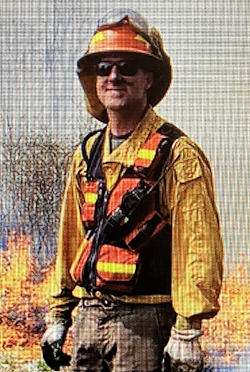
Nathan Johnson coordinates and conducts prescribed fires. Submitted photo
|
By Doug Mack
MnDOT employees rely on all kinds of tools to do their jobs, but not many use fire. Nathan Johnson does, regularly, as part of the agency’s efforts to ensure safe, beautiful roadways.
How long have you been at MnDOT and in what positions?
I have been with MnDOT for six years. Prior to that, I was with the DNR. Before my current position I was the assistant prescribed fire coordinator for MnDOT.
What does it mean to be a prescribed fire coordinator?
I coordinate and conduct prescribed fires statewide in a safe effective manner. I also organize trainings for burn crew members.
What are your day-to-day tasks and do they change throughout the year?
About 50% percent of my job is fire and the other 50% is vegetation reviews for construction projects in Districts 3, 4 and 8. During fire seasons, my day-to-day tasks are to search weather and determine if it would be a good weather day to light a fire. If weather is good, then I contact that district to start lining up appropriate people and equipment. This typically happens two to three days in advance. On the morning of the fire, I confirm all personnel and equipment are available and light the fire.
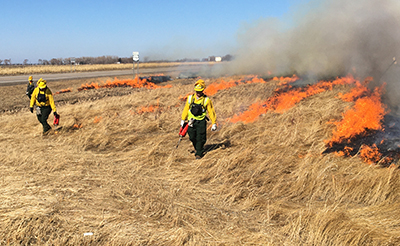
Nathan Johnson and his crew conduct a prescribed fire. Submitted photo
|
How does your job fit into the broader work of MnDOT?
Healthy roadside vegetation is necessary for preventing weed infestations, controlling erosion, protecting water quality and keeping roadways safe. Fire is an important aspect of vegetation management because many types of plants, especially native grasses and wildflowers, actually need fire for ideal growth. With MnDOT’s goal to increase use of native seed mixes, prescribed fire will play an important role in maintaining the investment. It's used in combination with mowing, herbicide application, biological control and planting in MnDOT’s Integrated Roadside Vegetation Management program.
What the most challenging and rewarding parts of your job?
The biggest challenge is controlling fire, of course. The most rewarding part is working with trained maintenance personnel in each district. Prescribed fires can be very dangerous and destructive if you don’t know what you are doing or don’t have the appropriate personnel and equipment. Burn crews in each district provide people with specific training and equipment to help perform burns as safely as possible.
How has your job changed since your first started?
When I first started, MnDOT had burn crews in four districts. Now, with District 7 starting in the spring of 2024, there will be burn crews in seven of the eight districts. Adding three additional crews expands everything I do and who I need to coordinate with.
Is there anything about your job that might surprise other people (either inside or outside MnDOT)?
In the last three years, we have established a Master Partnership Agreement with the DNR, which allows trained DOT fire personnel to assist DNR on wildfires in the state of Minnesota as well as out of state details. Tony Murilla from District 6 and I were on an 18-day fire detail in Manitoba in July for the DNR.
What are your interests or hobbies outside your work with MnDOT?
Fishing, hunting, basketball, volleyball, spending time with my wife and daughter, and being a volunteer for the Spicer Fire Department.
Do you or a co-worker have an interesting job to share with readers? Send us your ideas, and we’ll contact you for more information.
Recent employee profiles:
|
 |
|

|
 |
TABLE of CONTENTS
|
Join the Latino-American ERG in celebrating Día de los Muertos |
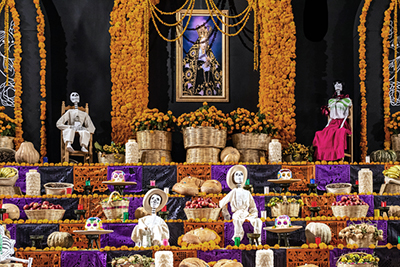
A community ofrenda in Oaxaca, Mexico. Photo by Gabriel Perez, Getty Images
|
By Frida Alvarez, Office of Equity & Diversity
Día de los Muertos – Day of the Dead – is coming soon, on Nov. 1 and 2. The holiday is most strongly associated with Mexico, where it originated, but it’s also celebrated in across Latin America and by the broader diaspora around the world, including in Minnesota.
On Día de los Muertos, the dead rejoin their communities and families for celebrations both public and private. The festivities include public parties and quiet, personal shrines known as ofrendas, all honoring those who have passed away. It’s a time to cherish community and family, and recognize the persistence of love, memory and relationships through death and beyond.
MnDOT’s Latino-American ERG invites all agency employees to celebrate Día de los Muertos at a Lunch and Learn on Nov. 3, from 12 p.m. to 1 p.m. This will a hybrid event, held in-person at the MnDOT Training and Conference Center in Shoreview and online via Teams.
The Lunch and Learn will discuss the history of Día de los Muertos and give instructions for making your own ofrendas—this is a hands-on event for anyone interested in getting crafty! The ERG will provide materials to people attending the in-person event. For anyone making their own ofrendas at home, the suggested materials include:
- A shoe box
- Tissue paper in any colors (used for covering the shoebox and making paper flowers)
- Colorful pipe cleaners (for the flowers)
- Scissors
- Clear tape or a glue stick
- Pictures of your loved one who has passed and who you would like to honor in the ofrenda (can be a human or a beloved pet)
- Assorted small things your loved one enjoyed (such as treats, drinks, trinkets or other items that remind you of them)
If you have any extra shoeboxes or other materials you’d like to donate to this event, please contact Frida Alvarez. |
 |
|

|
 |
TABLE of CONTENTS
|
Celebrate Hispanic/Latine Heritage Month with the Latino-American Employee Resource Group |
By Isela Xitlali Gómez, Office of Civil Rights, Latino-American Employee Resource Group co-chair
Hispanic/Latine Heritage Month is celebrated across the USA from Sept. 15 through Oct. 15.
Originally Hispanic/Latine Heritage observation started with one week in 1968, but this expanded to a 30-day period in 1988. HLM shines a spotlight on the unique voices and experiences of Hispanic/Latine Americans. It’s celebrated to honor histories, cultures and contributions of ancestors, journeys and achievements.
Throughout the heritage month, a number of anniversaries of independence are celebrated for Latin American countries such as Costa Rica, El Salvador, Guatemala, Honduras, Nicaragua, Chile and Mexico.
At MnDOT, the Latino-American Employee Resource Group is in the process of updating their iHUB site to include a poster series of some notable Latines throughout history and present day. Keep an eye out on an upcoming Newsline.
For more information about Hispanic/Latine Heritage Month please visit:
To learn more about the Latino-American Employee Resource Group if you are interested in being a member or ally of the group, contact at Isela Xitlali Gómez or Bri Alsides. |
 |
|

|
 |
TABLE of CONTENTS
|
Leadership Development Program participants engage in active on-site learning |
By Elizabeth Otto, Workforce Development

Pat Huston, assistant district engineer, District 1, explains aspects of the Twin Ports Interchange project to LDP participants Adam Frank and Robin Rust during a site visit. Photo by Elizabeth Otto
|
Leadership Development Program participants had the opportunity to attend three different trainings in September to learn from other MnDOT employees at the sites around the state.
On Sept. 14, twenty-five LDP participants gathered at the MnDOT Duluth headquarters for a training called District 1 Showcase. District Engineer Duane Hill presented information the unique challenges of District 1 and then Pat Huston, assistant district engineer, explained the process and progress of the Twin Ports Interchange project. LDP participants then toured the Twin Ports Interchange site to see the work for themselves. In a class evaluation after the training, one participant commented, “I learned how transportation and the port are vital to Minnesota's taconite, timber and tourism industries.” Another participant said, “This is a massive undertaking and they have done a great job.”
On Sept. 21, twenty-one LDP participants visited Snowplow Operator Training at Camp Ripley in Little Falls. Tony Marshall, maintenance training supervisor, educated the group about the history, purpose and basic procedure for the training. LDP participants viewed SPOT participants who were practicing maneuvering snowplows and the group traveled in vans on the route that SPOT participants follow when learning about plow operations. The LDP group also had the opportunity to see a plow up close as experienced SPOT trainers described the parts of the plow and shared explanations and stories about the realities of plowing for MnDOT. The group left the training with a better understanding of the combination of art, science and communication required to plow snow effectively and with a deeper appreciation for the MnDOT employees who do this valuable work.

LDP participants view one of the tanks at the I-35W Stormwater Storage Facility from the stairs near the bottom. Photo by Trish Signor
|
On Sept. 28, twenty-eight LDP participants met at Waters Edge in Roseville for a presentation from Tim Nelson, resident engineer at the Golden Valley Central Construction Office, about the I-35W Stormwater Storage Facility project. This first-of-its-kind structure for stormwater storage in Minnesota will hold more than 4.5 million gallons of water when it is completed in Oct. 2023. Since the project is near completion and is now fully enclosed, LDP participants completed confined space entry training provided by Metro Safety Administrators Jim Lonsky and Troy Bonin before traveling to the project site in Minneapolis. While recent rains meant that the group could not walk in the bottom of the tanks, LDP participants got a rare view of the underground facility as they descended 80 feet of stairs into one of the tanks.
LDP-administered trainings are open only to participants and alumni of the Leadership Development Program. Alumni (employees who have completed the Leadership Development Program in the past) may enroll in up to two LDP-administered trainings per calendar year. Active LDP participants must obtain supervisory approval before enrolling in any training, but there is no limit on the number of LDP-administered trainings they can take during their program year. LDP alumni are welcome to enroll again in the Leadership Development Program as active participants if they have supervisory approval.
The next open enrollment period for the Leadership Development Program will be from January 2 to January 31, 2024. Interested employees should visit the Leadership Development Program page on iHUB to learn more about LDP and how to enroll. |
 |
|

|
 |
TABLE of CONTENTS
|
Project managers gather to learn, plan and collaborate |
By Pamela Schubloom, Office of Project Management & Technical Support

Ross Bernstein presents “The Champion’s Code” to project managers. Photo by Pamela Schubloom
|
Statewide project managers, assistant district engineers and other managers who are accountable for project delivery gathered at the Mayo Civic Center in Rochester in September for the 2023 MnDOT Project Management Forum.
The event kicked off with the theme “Project Managers are Champions!” and a high energy welcome from Tom Styrbicki, Project Management and Technical Support director, and Mathew Thibert, engineer principal and event emcee from District 7.
The two-day event included more than a dozen sessions, centered on the “Champion” theme, led by agency staff from around the state, as well as representatives from Minnesota Management and Budget and Stantec. The various presenters informed project managers about the latest changes in their field of work and provided multiple opportunities for participants to collaborate with other district offices and Central Office specialty offices through various networking opportunities.
The event closed with a presentation by Ross Bernstein, a bestselling author of nearly 50 sports books. His message to project managers, titled “The Champion’s Code: Building Relationships Through Life Lessons of Integrity and Accountability from the Sports World to the Business World,” focused on the underlying questions of what sets sports champions apart from their competitors and how these lessons relate to the workplace. In feedback, event attendees stated that Bernstein’s presentation made them feel energized and refreshed and offered new insights about their work. |
 |
|

|
 |
TABLE of CONTENTS
|
Name That Place Puzzler #10 |
By Doug Mack
Can you name the place pictured below? The photo is from Street View and the satellite image is from the 511 website and app.
If you think you know the answer, email Newsline editor Doug Mack. The first three people to submit the correct answer will receive the fame and glory of having their names listed in the next issue of Newsline.
Answer to the last Puzzler: Dresbach Rest Area in La Crescent. The first three to get it right were James Smidt (District 6), Jeremy Erickson (District 4) and Patrick Gilbertson (Office of Land Management). Congrats to them and thanks to everyone who played!
If you know a place that would make a good Puzzler, please get in touch!
|
 |
|

|
 |
TABLE of CONTENTS
|
Highlighting the importance of mental health |
By Organizational Health Consultant Dr. Debra Lindh

Dr. Debra Lindh |
Maintaining mental health is an essential part of wellness, both in our personal lives and in the workplace, including our ability to serve the public as state employees.
As with our physical health, taking care of our mental health requires us to take steps on our own and also to support each other. Taking these actions, or having open conversations about them, is not always easy, which is why MnDOT has prepared a new video called “Talking Mental Health,” which serves as a starting point for discussing key aspects of employee wellbeing and mental health.
I encourage you to take some time to watch the video, which includes messages from leadership and colleagues from the state’s Employee Assistance Program and Organizational Health, who offer insights, guidance, support and information about available resources. It serves as an open and honest conversation about the importance of mental health and how we as an organization are committed to creating a culture of wellbeing, understanding, and mutual support.
You can find the video on the MnDOT YouTube channel. As an alternative to watching the video alone, the Office of Human Resources is in the process of scheduling Lunch and Learns where a group of employees can watch the video together where I will be available to answer questions, as the agency’s organizational health consultant. The dates and details of the Lunch and Learns will be shared with employees soon.
I also encourage all MnDOT employees to participate in World Mental Health Day on Tuesday, Oct. 10.
This awareness day was established by the World Federation for Mental Health in 1992 and has become an annual global event with the purpose of reducing stigma, providing education and advocating for mental health care and support. It serves as a vital reminder of the importance of mental health and encourages open conversations about mental health and overall wellbeing.
Here are a few ways to participate in World Mental Health Day:
- Raise awareness: Hold an informal team discussion like a pop-soda-coffee-water break and encourage folks to share their thoughts, experiences, and questions about mental health.
- Education: Learn about mental health challenges, their impact, and resources; read from sources such as the Minnesota Employee Assistance Program, Mental Health America or the World Health Organization addressing myths, misconceptions and misinformation about mental health.
- Volunteer: Get involved with groups like the Wellness Committee, collaborate with areas such as Organizational Health, Equity and Diversity, Workforce Development and Safety, and look for ways to contribute to our communities.
- Support: Be there for others. Offer support and a listening ear to friends, family or colleagues who may be struggling with their mental health. When we understand mental health challenges, and how to respond, it can make all the difference. By taking notice and offering support, it says, “I’m here, I have your back, you are not alone.”
- Lead by example: Normalize the conversation by emphasizing that everyone’s mental health matters, and it’s a topic that is okay to talk about.
- Share: Share resources, information, tools, and tips that have been effective in supporting mental health and well-being.
- Recognize: Recognize that mental health is health. It is a concern that affects everyone. We can take meaningful action, not just on Oct. 10 but every day throughout the year.
Together, we can make a long-lasting impact on the mental health and well-being of folks throughout MnDOT and to our communities worldwide.
Thank you for your dedication and making a positive difference every day. Your mental health and wellbeing matter, and together we thrive. |
 |
|
|
|



